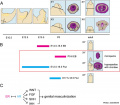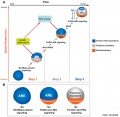Category:Wnt: Difference between revisions
mNo edit summary |
mNo edit summary |
||
| Line 1: | Line 1: | ||
This | This {{Embryology}} category shows pages and media related to the Wnt signalling pathway in development. | ||
A secreted glycoprotein patterning switch with different roles in different tissues and signaling has generally been divided into the canonical and non-canonical pathways. The name was derived from two drosophila phenotypes '''w'''ingless and i'''nt''' and the gene was first defined as a protooncogene, int1. Humans have 19 identified members, with the major subgroup of Wnts (WNT1, WNT3A, WNT8) signaling through activation of [[B#beta-catenin|beta-catenin]] dependent transcription from at least 4 WNT genes encoding secreted glycoproteins. At least one wnt receptor called [[F#frizzled|frizzled]] (FZD). Wnt7a is secreted protein and binds to extracellular matrix. The mechanism of Wnt distribution (free diffusion, restricted diffusion and active transport) and all its possible cell receptors are still being determined. In the gastrointestinal system, Wnt maintains the pool of undifferentiated intestinal progenitor cells and control maturation and correct positioning of the Paneth cell (a differentiated intestinal cell type). | A secreted glycoprotein patterning switch with different roles in different tissues and signaling has generally been divided into the canonical and non-canonical pathways. The name was derived from two drosophila phenotypes '''w'''ingless and i'''nt''' and the gene was first defined as a protooncogene, int1. Humans have 19 identified members, with the major subgroup of Wnts (WNT1, WNT3A, WNT8) signaling through activation of [[B#beta-catenin|beta-catenin]] dependent transcription from at least 4 WNT genes encoding secreted glycoproteins. At least one wnt receptor called [[F#frizzled|frizzled]] (FZD). Wnt7a is secreted protein and binds to extracellular matrix. The mechanism of Wnt distribution (free diffusion, restricted diffusion and active transport) and all its possible cell receptors are still being determined. In the gastrointestinal system, Wnt maintains the pool of undifferentiated intestinal progenitor cells and control maturation and correct positioning of the Paneth cell (a differentiated intestinal cell type). | ||
Revision as of 10:58, 10 June 2015
This Embryology category shows pages and media related to the Wnt signalling pathway in development.
A secreted glycoprotein patterning switch with different roles in different tissues and signaling has generally been divided into the canonical and non-canonical pathways. The name was derived from two drosophila phenotypes wingless and int and the gene was first defined as a protooncogene, int1. Humans have 19 identified members, with the major subgroup of Wnts (WNT1, WNT3A, WNT8) signaling through activation of beta-catenin dependent transcription from at least 4 WNT genes encoding secreted glycoproteins. At least one wnt receptor called frizzled (FZD). Wnt7a is secreted protein and binds to extracellular matrix. The mechanism of Wnt distribution (free diffusion, restricted diffusion and active transport) and all its possible cell receptors are still being determined. In the gastrointestinal system, Wnt maintains the pool of undifferentiated intestinal progenitor cells and control maturation and correct positioning of the Paneth cell (a differentiated intestinal cell type).
- Links: Wnt
Pages in category 'Wnt'
The following 8 pages are in this category, out of 8 total.
Media in category 'Wnt'
The following 18 files are in this category, out of 18 total.
- Canonical Wnt signaling in Wnt5a KO limb buds.jpg 1,280 × 701; 132 KB
- Chicken- limb bud chondrogenesis.jpg 600 × 1,032; 163 KB
- Chicken- neural Wnt expression.jpg 600 × 424; 55 KB
- Chicken- wing cartilage.jpg 1,200 × 1,022; 218 KB
- Chicken-limb sox9 wnt6.jpg 1,173 × 373; 68 KB
- European Wnt Meeting Sep2018.jpg 841 × 1,190; 178 KB
- Female reproductive tract Wnt4.jpg 1,000 × 563; 79 KB
- Gastrulation molecular factors01.jpg 750 × 549; 105 KB
- Hox 3 phase model.jpg 1,030 × 800; 81 KB
- Limb bud geometry and patterning.jpg 583 × 765; 76 KB
- Mouse external genital development.jpg 800 × 701; 75 KB
- Mouse sex determination genes 01.jpg 1,280 × 923; 73 KB
- Mouse Wnt signaling 01.jpg 600 × 450; 156 KB
- Mouse- facial branchiomotor neuron migration.jpg 600 × 841; 104 KB
- Non-canonical Wnt signaling.jpeg 1,280 × 980; 215 KB
- Sea urchin Wnt patterning model.jpg 1,029 × 1,000; 110 KB
- Wnt signal pathway.jpg 1,280 × 422; 125 KB














